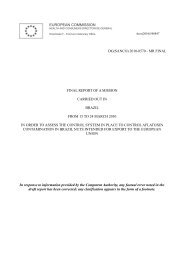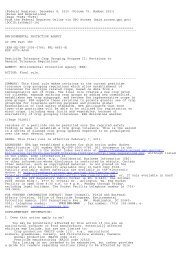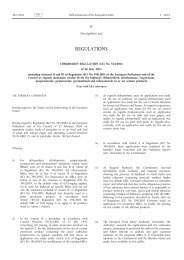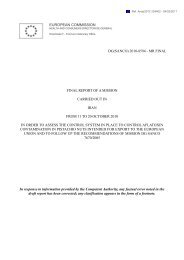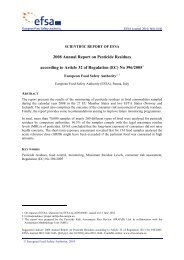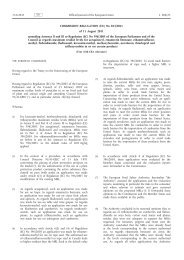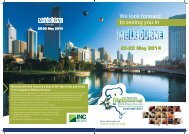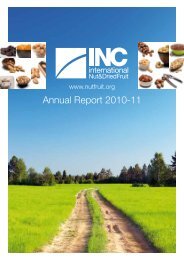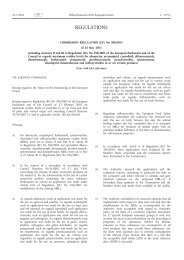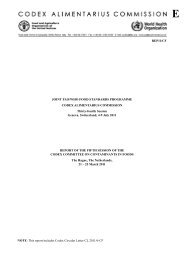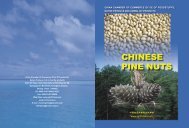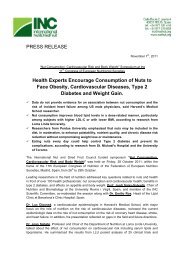REP11/PR JOINT FAO/WHO FOOD STANDARDS PROGRAMME ...
REP11/PR JOINT FAO/WHO FOOD STANDARDS PROGRAMME ...
REP11/PR JOINT FAO/WHO FOOD STANDARDS PROGRAMME ...
You also want an ePaper? Increase the reach of your titles
YUMPU automatically turns print PDFs into web optimized ePapers that Google loves.
<strong>REP11</strong>/<strong>PR</strong> 16<br />
148. The Committee noted that several signatory countries of the Stockholm Convention had not yet ratified the revision of Annex<br />
A and that decisions taken at the Convention did not have an immediate effect on the work of the Committee on Pesticide Residues<br />
which should follow the procedures laid down in the Procedural Manual, i.e. Risk Analysis Principles applied by CC<strong>PR</strong>, for the<br />
revocation of CX MRLs or the conversion of Codex MRLs into EMRLs.<br />
149. A number of delegations informed the Committee that uses of lindane for agricultural purposes are prohibited in their<br />
countries. Some of these delegations noted that, as this compound is a persistent organic pollutant in the environment (e.g. soil),<br />
presence of lindane in foods may warrant monitoring.<br />
Conclusion<br />
150. The Committee agreed that, because lindane is prohibited in certain countries and is also persistent in the environment,<br />
member states should monitor presence of lindane in food commodities and to provide data to JM<strong>PR</strong> within a period of 2 years for<br />
JM<strong>PR</strong> to review the monitoring data in 2015 prior to decision of conversion of MRLs to EMRLs.<br />
DISCUSSION PAPER ON JM<strong>PR</strong> RESOURCE ISSUES IN THE <strong>PR</strong>OVISION OF SCIENTIFIC ADVICE TO CC<strong>PR</strong> (Agenda Item<br />
13a) 21<br />
151. The Delegation of the United States of America presented the discussion paper on the resource issues faced by JM<strong>PR</strong>, as<br />
requested by the 42 nd Session of the CC<strong>PR</strong> and also referred to information and comments provided by the 2010 JM<strong>PR</strong> (General<br />
Consideration, section 2.1). The Delegation highlighted that the demand on JM<strong>PR</strong> has increased in recent years and the resource<br />
constraints are limiting the number of reviews able to be completed each year with the review schedule for new chemicals is<br />
expected to be at capacity up to 2014.<br />
152. The discussion paper identified three primary issues of concern: funding, the availability of expertise, and the timing/frequency<br />
of JM<strong>PR</strong> meetings. The Committee noted that this increase in demand is indicative of the success of the process improvements that<br />
have been implemented in the past several years by the CC<strong>PR</strong> and the improved decision-making process in CC<strong>PR</strong>. The Committee<br />
agreed that lack of funding and the availability of expertise must be addressed before any of the options suggested in the paper<br />
could be implemented (such as holding more frequent meetings and Increasing the number of experts.)<br />
153. Various opinions presented at the discussion on the points raised in the paper. The JM<strong>PR</strong> Secretariat mentioned that there is<br />
an option for member countries to provide targeted funding for JM<strong>PR</strong> under the Scientific Advice Initiatives.<br />
Conclusion<br />
154. The Committee concluded that the CC<strong>PR</strong> itself could not solve the problem, but need to be addressed at high level.<br />
155. The Committee agreed that the JM<strong>PR</strong> resource issues should be raised by the member countries of <strong>FAO</strong> and <strong>WHO</strong> at the<br />
highest level possible, and that member countries could express their concerns at the next session of the Codex Alimentarius<br />
Commission.<br />
156. In light of the large number of compounds eligible for periodic review, the Committee agreed that, the electronic Working<br />
Group on Priorities should consider ranking them on the basis of health risks to assist setting the priority list at the next meeting.<br />
ASSESSMENT OF MRLS FOR PESTICIDES IN TEA (Agenda Item 13b) 22<br />
157. The Committee was informed that the <strong>FAO</strong> Intergovernmental Group (IGG) on Tea has proposed to change the risk<br />
assessment associated with in the establishment of MRLs of pesticides in tea and the analytical methods used to identify the<br />
presence of pesticides in tea from the leaf to brew, or to pay equal attention to both, the leaf and brew, to provide correct and direct<br />
information to consumers as tea was used to make an infusion in water in most cases. The Committee noted that the rationale for<br />
this proposal was presented in CX/<strong>PR</strong> 11/43/16.<br />
158. The JM<strong>PR</strong> Secretariat noted that transfer of residues into tea infusion is already part of risk assessment and information on<br />
standard procedure of testing methodology and relevant scientific studies (in particular processing factors) would be welcome. The<br />
Secretariat also advised that MRLs are set on tea leaves, not on tea brew as the leaves are the product commonly and<br />
internationally traded.<br />
159. Some delegations informed the Committee that tea was an important crop in their countries and they might submit data and<br />
information if requested.<br />
21 CX/<strong>PR</strong> 11/43/15. Comments from Kenya (CRD 5) and Australia (CRD 26).<br />
22 CX/<strong>PR</strong> 11/43/16.



